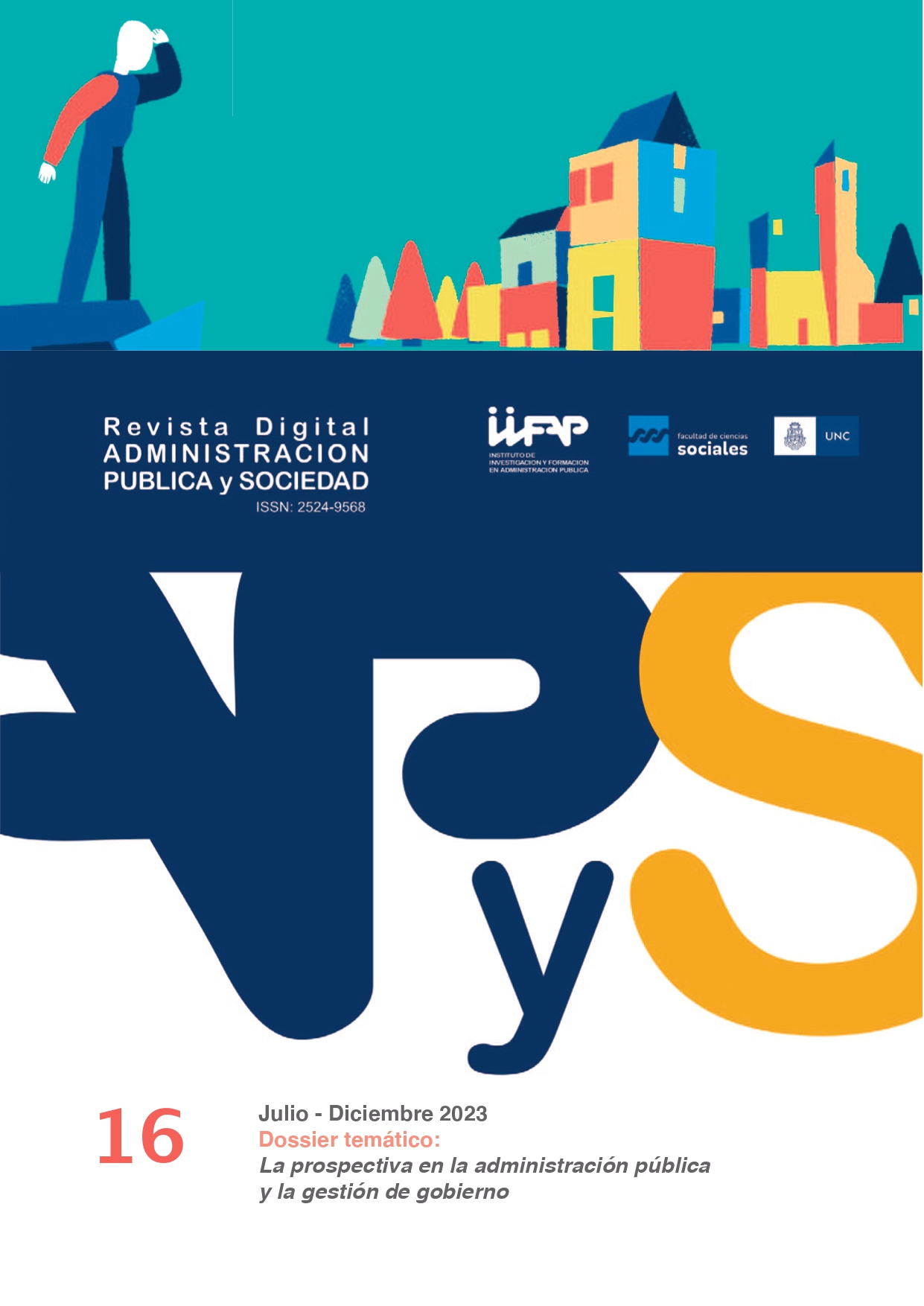The State-Citizenshio relation through digital technologies Current situation and reflexions on the future in argentina's national public administration.
Main Article Content
Abstract
This paper presents a prospective study focused on the analysis of digital technologies in the Argentine Public Administration, carried out by the Prospective and Future Scenarios Unit of the National Institute of Public Administration.
The research integrates a conceptual framework that incorporates the notions of open socio-technical systems and organizational technologies, as well as the models of electronic, digital and open government.
In turn, it employs a methodological strategy that is developed in several stages, including literature review, interviews, focus groups and discussions, in addition to the processing of information through specialized software that assists in the design of future scenarios.
In the baseline, four systems are analyzed: Integrated Financial Information System Internet (e-SIDIF), Electronic Document Management (GDE), Remote Procedures (TAD), and My Argentina.
In order to enrich the following phases of the study, based on the information obtained, four key axes are introduced for the analysis of digital technologies: critical infrastructure, organizational transformation, link with citizenship, and data and algorithmic governance.
In addition, the research projects possible future scenarios, relating its results to three different Public Administration models: New Public Management, Polygovernance and Neoweberianism.
Within this framework, this article aims, on the one hand, to give an account of the process developed throughout the research. And on the other hand, to deepen the analysis of one of the axes proposed for the study, the link between the State and citizenship.
Article Details

This work is licensed under a Creative Commons Attribution-NonCommercial-ShareAlike 4.0 International License.
Authors who publish in this journal accept the following terms of the copyright policy:
- Authors shall retain their copyright (including copyrights) and shall grant to the journal the right of first publication of their work, which shall simultaneously be subject to the Creative Commons Recognition License: No commercial use of the original work or any derivative works is permitted, distribution of which must be made under a license equal to that which governs the original work.
- Authors may adopt other non-exclusive license agreements for the distribution of the version of the published work (e.g., placing it in an institutional repository or publishing it in a book) provided that the initial publication in this journal is indicated.
- Authors are allowed and encouraged to disseminate their work through the Internet (e.g., in institutional repositories or on their website) after the publication process, which may lead to interesting exchanges and increased citations of the published work. (See The Effect of Open Access).
How to Cite
References
Blutman, G. y Cao, H. (2019). El futuro del Estado en la Argentina. Escenarios en disputa hacia el año 2030. EDICON.
Blutman, G., Cao, H. [et al.]. (2023). Materia Estado. El futuro del empleo público, las tecnologías digitales y las estructuras estatales. Instituto Nacional de la Administración Pública.
Cao, H. y Vaca, J. (2019). Dialéctica del desarrollo argentino entre el territorio y la sociedad de la información. Revista de Ciencias Sociales, 10(35), 153-171.
Emery, F. E. (1959). Characteristics of socio-technical systems. (Document N.° 527). Tavistock Institute.
Estévez, E. y Solano, M. (2023, 24 de mayo). Revolución de la IA: desafíos y oportunidades para la Administración Pública en la Era Digital. CIPPEC.
Felcman, I. y Blutman, G. (2020). Cultura organizacional: nuevos dioses y la búsqueda del eslabón perdido para la transformación del Estado. Cuadernos del INAP (CUINAP), 1(18).
Memorandum for the Heads of Executive Departments and Agencies. Transparency and Open Government. Publicado en el Federal Register el 26 de enero de 2009.
Organización para la Cooperación y el Desarrollo Económicos (2019). Índice de Gobierno Digital OCDE 2019. Resultados y mensajes clave.
Páez Arenas, A., Chirino, C., Bisurgi, F. y Rodrigo, R. (2023). Los desafíos sociotécnicos digitales para el desarrollo de las administraciones públicas futuras. Cuadernos del INAP (CUINAP), 4(111).
Pasmore, W. & Khalsa, G. (1993). The contributions of Eric Trist to the social engagement of social science. Academy of Management Review, 18(3), 546-569.
Suárez, F. y Felcman, I. (2020). Tecnología y Organización. Cuadernos del INAP (CUINAP), 1(38).
Suárez, F. y Felcman, I. (1975). Tecnología y Organización. El Coloquio.
Thompson, J. D. (1967). Organizations in Action: Social Science Bases of Administrative Theory. McGraw-Hill.
Trist, E. L. & Bamforth, K. W. (1951). Some social and psychological consequences of the longwall method of coal-getting. Human Relations, 4(1), 3-38.
Trist, E. L., Higgin, G. W., Murray, H. & Pollock, A. B. (1963). Organizational choice: Capabilities of groups at the coal face under changing technologies. The loss, rediscovery & transformation of a work tradition. Tavistock.
Van Dijk, J. & Hacker, K. (2003). The Digital Divide as a Complex and Dynamic Phenomenon. The Information Society, 19(4), 315-326.
Zuiderwijk, A., Chen, Y. C. & Salem, F. (2021). Implications of the use of artificial intelligence in public governance: A systematic literature review and a research agenda. Government Information Quarterly, 38(3), 101577.

